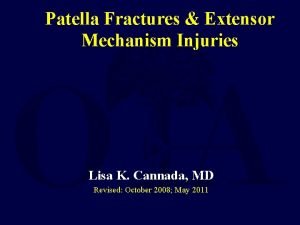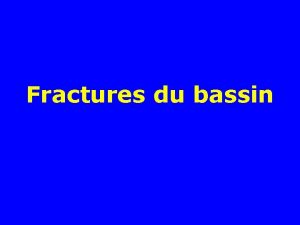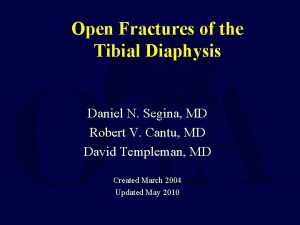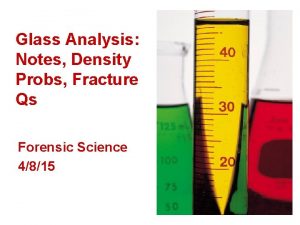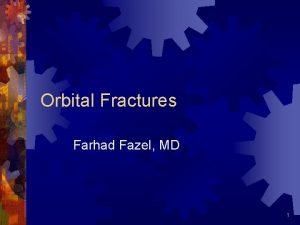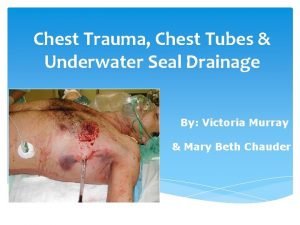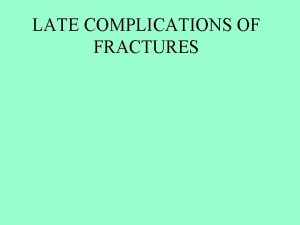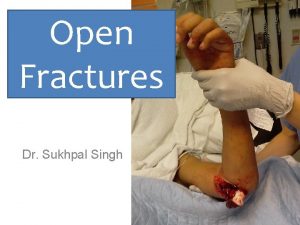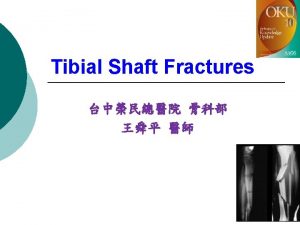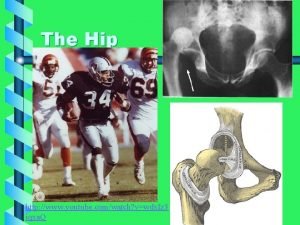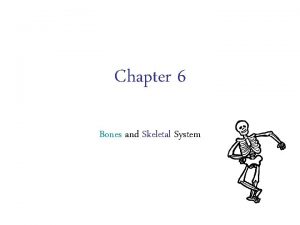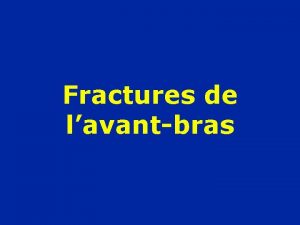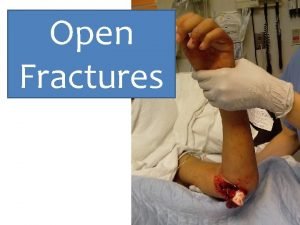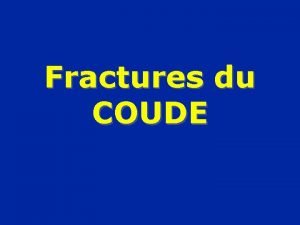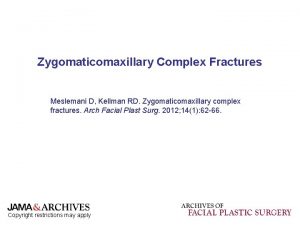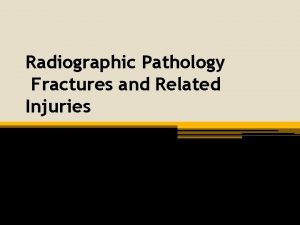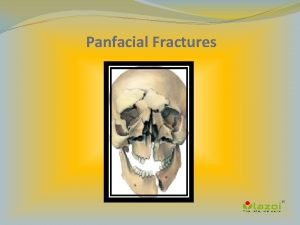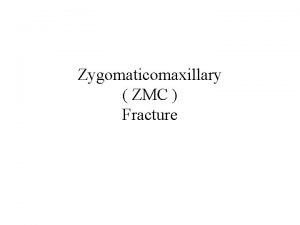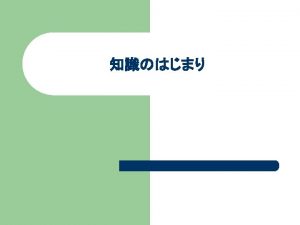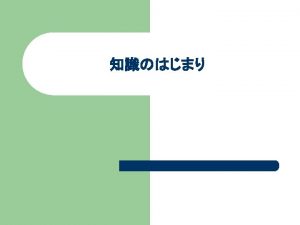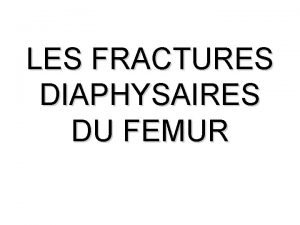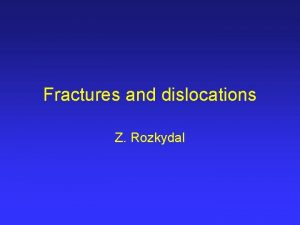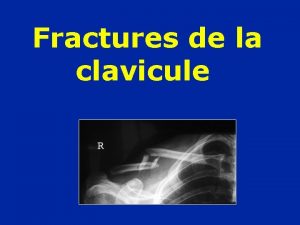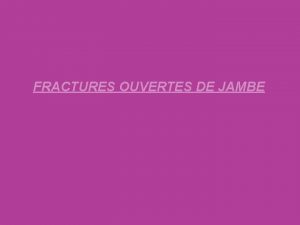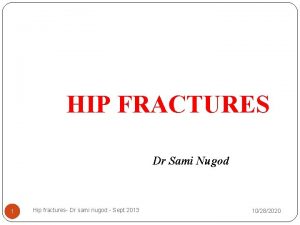Zygomaticomaxillary Complex Fractures Meslemani D Kellman RD Zygomaticomaxillary

















- Slides: 17

Zygomaticomaxillary Complex Fractures Meslemani D, Kellman RD. Zygomaticomaxillary complex fractures. Arch Facial Plast Surg. 2012; 14(1): 62 -66. Copyright restrictions may apply

Introduction • Zygomaticomaxillary complex (ZMC) fractures can result in disfigurement; even after reduction and fixation, there is a high risk for asymmetry. • This review presents the classification, morbidities and complications, diagnostic evaluation, and treatment of ZMC fractures. Copyright restrictions may apply

Methods • Study Design: literature review. • Referenced publications were retrospective studies of patients with ZMC fractures. Copyright restrictions may apply

Results • ZMC fractures are the second most common facial fracture (second to nasal fractures). • The ZMC’s 3 -dimensional configuration and the anatomic approximation of the ZMC to the orbit and infraorbital foramen contribute to orbital and neuropathic morbidities and asymmetry frequently seen with ZMC fractures, even after reduction. Copyright restrictions may apply

Results • ZMC Fracture Classifications – Knight and North, with groups I through VI based on anatomic alterations: • I: No significant displacement. • II: Inward buckling of malar eminence. • III: Unrotated body fractures. • IV: Medially rotated body fractures. • V: Laterally rotated body fractures. • VI: Complex fractures. – Knight and North indicated that groups II and V required only closed reduction without fixation, whereas groups III, IV, and VI required fixation. – However, Pozatek et al determined that up to 60% of group V cases were unstable for closed reduction. Copyright restrictions may apply

Results • ZMC Fracture Classifications – Manson et al devised a computed tomographic scan–based classification system. • Low-energy fractures: incomplete fractures with minimal displacement. • Medium-energy fractures: complete fractures with moderate displacement. • High-energy fractures: associated with other midface fractures, most severe type. Copyright restrictions may apply

Results • ZMC Fracture Classifications – Zingg et al developed a system based on site and quantity of fractures: • Type A: only 1 site (ie, arch, lateral orbital rim, or inferior orbital rim). • Type B: fractures in all 4 suture lines of the ZMC. • Type C: comminuted fractures. Copyright restrictions may apply

Results • Epidemiology of ZMC Fractures – Ellis et al reported that most ZMC fractures are the result of assaults, falls, sporting activities, and motor vehicle crashes. – Incidence decreased as a result of seatbelt laws. – Air bags did not change the incidence of ZMC fractures. – 25% of ZMC fractures are associated with other facial fractures. Copyright restrictions may apply

Results • Clinical Presentation – Swelling, edema, ecchymosis, and/or subcutaneous emphysema in the ZMC region. – Depression of the ZMC may not be evident until the swelling and edema resolve. – Pain, tenderness, and/or numbness (infraorbital nerve dysfunction). – Trismus may be present (likely due to impingement of the temporal muscle or coronoid process by a depressed zygomatic arch). – Diplopia (fracture through zygomaticosphenoid suture with entrapment of extraocular muscle[s]). – Enophthalmos (herniation of orbital content). Copyright restrictions may apply

Results • Imaging – Computed tomographic scan (gold standard). • High resolution. • 3 -Dimensional computed tomography enables better visualization of malpositioned bone, but does not replace 2 -dimensional computed tomography. • Axial and coronal. • 2 -Dimensional computed tomography is better for orbital fractures and soft-tissue deformities. – Plain radiography is not the current standard. Copyright restrictions may apply

Results • Treatment Options – Observation. – Closed reduction without fixation. – Open reduction with fixation at 1 or more buttresses. Copyright restrictions may apply

Results • Treatment of ZMC Fractures – Indications for open reduction and internal fixation: • Infraorbital nerve compression (numbness). • Impingement on coronoid process or temporal muscle (trismus). • Diplopia due to entrapment of extraocular muscle(s) (urgent). • Exophthalmos or orbital apex syndrome (emergent). • Enophthalmos. • Aesthetic deformity (ie, depressed ZMC). Copyright restrictions may apply

Results • Open Reduction And Internal Fixation Treatment – 4 Principles: • Adequate exposure. • Proper reduction. • Stable fixation. • Minimize complications. – Common philosophy: • Treat each fracture individually. • Fixate the fracture with the least amount of plating and disruption of soft tissue. • Preoperative ophthalmologic evaluation in cases with an orbital component. Copyright restrictions may apply

Results • Surgical Approaches – Sublabial-vestibular. – Orbital approaches (avoid if possible): • Subciliary (transient ectropion [12% of patients], permanent scleral show [28% of patients]). • Transconjunctival (permanent scleral show [3% of patients], low risk of entropion). • Subtarsal (unless there is an existing laceration, avoid entirely because of poor cosmesis and prolonged edema). – Gilles or hemicoronal for the zygomatic arch. – Endoscopic. Copyright restrictions may apply

Results • Surgical Reduction – Bone hook. – Carroll-Girard screw. – Finger palpation of fracture lines. – Gilles, hemicoronal. • Fixation – Stability examined sequentially during reduction and fixation to determine the extent of needed fixation. – Zygomaticomaxillary buttress, frontozygomatic suture, infraorbital rim, zygomatic arch, and nasomaxillary buttress should all be examined for changes and stability during reduction. Copyright restrictions may apply

Comment • ZMC fractures can be challenging to manage. • The complex 3 -dimensional appearance and location result in difficulty with reduction and fixation. • There is no consensus regarding proper management. Copyright restrictions may apply

Contact Information • If you have questions, please contact the corresponding author: – Robert M. Kellman, MD, Department of Otolaryngology and Communicative Sciences, State University of New York Upstate Medical University, 241 Campus W, 750 E Adams St, Syracuse, NY 13210 (kellman@upstate. edu). Copyright restrictions may apply
 Lisa kasman
Lisa kasman Disjonction symphyse pubienne classification
Disjonction symphyse pubienne classification Types of glass fractures
Types of glass fractures Classification of open fractures
Classification of open fractures Types of glass fractures
Types of glass fractures Farhad fazel
Farhad fazel Chest tube management nursing
Chest tube management nursing Algodystrophy
Algodystrophy Dr sukhpal singh
Dr sukhpal singh Gustilo anderson classification antibiotics
Gustilo anderson classification antibiotics Ilioposas
Ilioposas Types of fractures with pictures
Types of fractures with pictures Bone cancer fractures
Bone cancer fractures Irving tennis elbow
Irving tennis elbow Fracture bois vert
Fracture bois vert Open fracture treatment
Open fracture treatment Classification fracture supracondylienne
Classification fracture supracondylienne Triradiate cartilage x ray
Triradiate cartilage x ray
